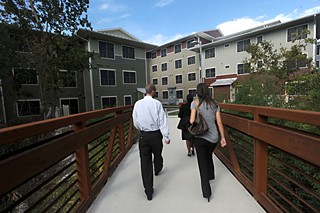Entering Into Bondage
The Citizens Task Force takes up the fall bond package planning
By Michael King, Fri., March 2, 2012

Got a spare $1.5 billion?
If you don't already have your own Super PAC, you might find that price tag a little daunting. Seriously, that's the grand total ($1,492,658,000) of the city of Austin's overall "Needs Assessment" from 13 departments, ranging from the low end at Economic Growth and Redevelopment Services (a mere
$2 million) to the upmarket number at Planning and Development Review ($300 million). The entire summary, compiled from lists of 124 potential projects proposed from inside and outside city departments, comes in at roughly 175 pages, and amounts to a citywide wish list – prior to setting priorities.
That's the job of the Bond Election Advisory Task Force, a City Council-appointed group of 15 citizens with hopefully strong stomachs and long attention spans, which has begun hearing public testimony, plowing through documents, determining urgency, and trying to cut that $1.5 billion number in half or a third – to put together a bond package to recommend to council in May and ultimately to the voters in November. A few of the big-ticket items under consideration are:
• General street reconstruction: $90 million
• New APD headquarters: $78 million
• New Fire/EMS headquarters: $76 million
• Affordable housing projects: $75 million
• Improvements to I-35 corridor: $50 million
• Open space acquisition: $50 million
• Waller Creek & related trail improvements: $40 million
None of this is written in stone, and the bond advisory process is a welter of meetings, presentations, and eye-glazing detail. Departments developed their project lists – emphasizing those proposals that could be completed in five to seven years – which were then scored by planning staff on the basis of 50 "guiding principles" provided by council and organized under the categories of Infrastructure, New Initiatives, Mobility, Sustainability, Cost Effectiveness, and a Balanced Approach (the latter ranging from budget impact to geographic distribution). The task force has been asked to design project packages at $500 million, $600 million, and $725 million (each level marking the effect of raising the property tax rate from 1 to 3 cents per $100 valuation; using available bond capacity that would not raise the rate would require holding the package under $400 million). Notably, the list of mobility projects does not include a proposed urban rail system, although that has been on the planning wish list (including that of the mayor and council) for some time.
A taste of the complexity of the process could be had last Thursday night, at the first meeting of the City Facilities Committee, one of four task force subcommittees (the others are Parks & Open Space, Transportation/Mobility, and Affordable Housing). Virtually before the meeting began – the group hadn't even elected a chair – the members were being asked to add another project to the already lengthy list. Juan Oyervides, board chair of the Mexican American Cultural Center, requested consideration of an additional $42 million for Phase II of the MACC's master plan, specifically for a 300-seat theatre and a parking garage. (Committee members requested more detailed budget information to be added to the burgeoning stack of documents.)
First on the official presentation agenda was the library department. Library facilities planning manager John Gillum led the committee through the library's fairly modest, PowerPoint-illustrated project list: new roofs for the Pleasant Hill and Will Hampton branches, new HVAC for Pleasant Hill, a sprinkler system for the library warehouse, renovations for half a dozen branches (including the History Center); expanding the parking lot at University Hills. Gillum noted that the library's current development energies are fully occupied with planning the new Central Library (approved in the 2006 bond package), and that its bond project list is focused on "maintaining what we have" and facility sustainability: "If you can't maintain it, it's not sustainable." Committee members had a few questions, raising issues of "shared use" (yes, to the rather limited extent feasible), whether out-of-towners can use the libraries they don't pay for (yes, under state law), and where these projects fit into the library's long-term planning. Gillum touched on the latter (an eventual desire for larger regional libraries served by satellite branches), and only very lightly on the library's perennial targeting in annual city budget cuts: "They told me to be circumspect," he said with a smile.
The committee – Frank Fernandez (chairing the task force and now this subcommittee), Rodney Ahart, Craig Enoch, Jennifer Kim, Leslie Pool, Heather Way – was still finding its way, and responded to Gillum's presentation with tentative, friendly brainstorming. The mood may shift in the coming weeks, as each subcommittee plows through the scores of potential projects and millions of dollars in requests, trying to find ways to turn $1.5 billion into $500 million or less.
Got something to say on the subject? Send a letter to the editor.








